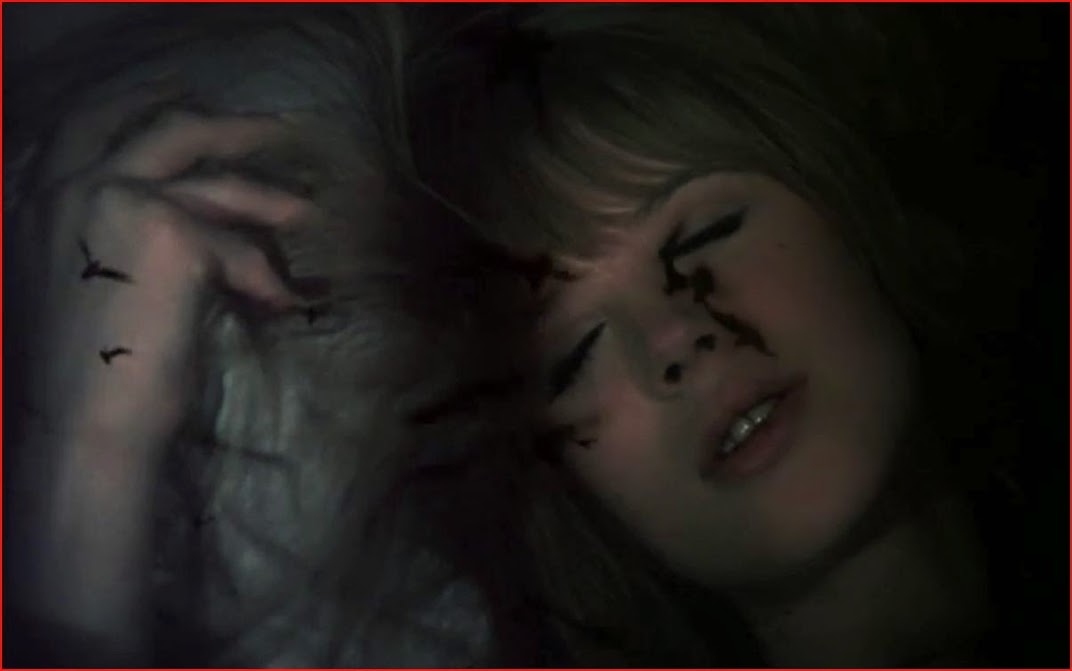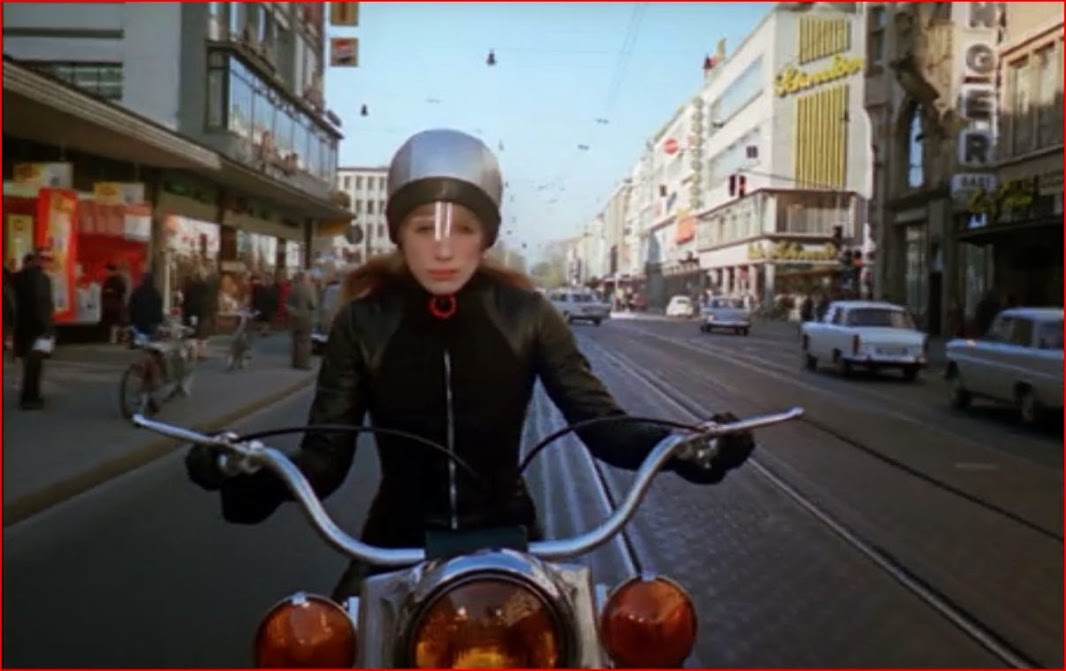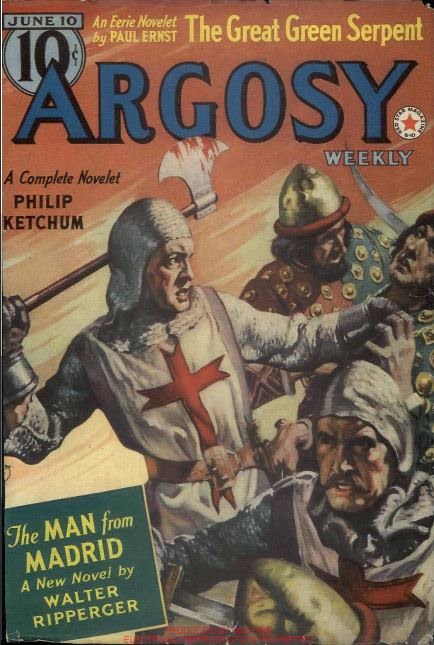 Looking at Pre-Code musicals over the years, I developed the notion that Fred Astaire and Ginger Rogers saved the genre from evolving into live-action cartoons by stressing virtuoso talent rather than mass choreography a la Busby Berkeley -- often brilliant visually but always potentially soulless -- or outright cartoonish stories with little real feeling, much less romance in them. But while Astaire and Rogers certainly revolutionized musicals in their own way, as Berkeley had revolutionized and "saved" the genre shortly before, the fact remained in the era of Code Enforcement that there were fewer virtuoso performers than could satisfy the demand for musical comedy films. As a result, you still saw musicals that were essentially human cartoons. Paramount seemed to specialize in these, as they seemed most committed to using musicals to putting over radio comedians as movie stars. As a result, here is a musical, directed by Frank Tuttle with a script by many hands, headlined by a performer best known as an anti-virtuoso. Jack Benny made a running gag that lasted almost his entire long career, until he staged some serious performances to set the record straight, that he was a lousy violinist. Benny must seem an enigmatic figure today, having risen to stardom on a perceived absence of talent. The gimmick worked on his radio program, in which he made himself the butt of jokes from his supporting players. But Benny didn't bring his radio support network to this project, and that exposes him somewhat as a personality with relatively little to offer. At the time, when people knew all he wanted them to know about his character, audiences presumably got what was funny in his mannerisms. At the same time, you get the idea that any comedian could have played Benny's part: a bandleader-turned-manager of a failing resort, dodging creditors and law enforcement until an improbable patroness (Mary Boland) gives him a gimmick that can turn the place's fortunes around.
Looking at Pre-Code musicals over the years, I developed the notion that Fred Astaire and Ginger Rogers saved the genre from evolving into live-action cartoons by stressing virtuoso talent rather than mass choreography a la Busby Berkeley -- often brilliant visually but always potentially soulless -- or outright cartoonish stories with little real feeling, much less romance in them. But while Astaire and Rogers certainly revolutionized musicals in their own way, as Berkeley had revolutionized and "saved" the genre shortly before, the fact remained in the era of Code Enforcement that there were fewer virtuoso performers than could satisfy the demand for musical comedy films. As a result, you still saw musicals that were essentially human cartoons. Paramount seemed to specialize in these, as they seemed most committed to using musicals to putting over radio comedians as movie stars. As a result, here is a musical, directed by Frank Tuttle with a script by many hands, headlined by a performer best known as an anti-virtuoso. Jack Benny made a running gag that lasted almost his entire long career, until he staged some serious performances to set the record straight, that he was a lousy violinist. Benny must seem an enigmatic figure today, having risen to stardom on a perceived absence of talent. The gimmick worked on his radio program, in which he made himself the butt of jokes from his supporting players. But Benny didn't bring his radio support network to this project, and that exposes him somewhat as a personality with relatively little to offer. At the time, when people knew all he wanted them to know about his character, audiences presumably got what was funny in his mannerisms. At the same time, you get the idea that any comedian could have played Benny's part: a bandleader-turned-manager of a failing resort, dodging creditors and law enforcement until an improbable patroness (Mary Boland) gives him a gimmick that can turn the place's fortunes around.Boland was a queen of misrule in the Pre-Code musical comedy Down to Their Last Yacht and her role here has the same potential. She's Carola P. Gaye, a wealthy widow determined to bankroll the enthusiasms of her latest paramour, Hercules Dove (Etienne Giradot). Hercules is a feeble old man with a Greek fetish. He dresses in classical garb and wants to revive classical ideals of human perfection through the new science of eugenics. He and Carola take over Benny's hotel -- he runs it for the film's ingenue (Marsha Hunt) -- and hope to turn it into a breeding ground for the best specimens of American youth, recruited from colleges across the country. They send Benny to do the recruiting, accepting his suggestion that they make it into a talent search for entertainers. They are adamant, however, that the breeding not begin until all the subjects have arrived at the hotel. There, boys will be paired with girls through the oracular intervention of Hercules's daughter Calliope, whom he touts as the perfect modern woman, and for whom he seeks a suitable mate with the dimensions of the famous Apollo Belvedere sculpture. It's up to Benny to keep the college kids from necking and petting on the transcontinental train trip. He then hopes to use the kids in a modern musical revue despite Carola and Hercules's eugenic intentions.
Presumably it was up to Benny to determine the kids' suitability, and he chose a lot of entertainers. Classical standards of beauty were waived, apparently, for the darling of Corn City College (Martha Raye), whose main attributes are a loud mouth and superhuman strength. She flings heavy suitcases as if they were softballs and does a Samson stunt -- not in the script! -- during the rehearsal of a number set in a classical temple. But classical standards are moot once we are introduced, after some build-up, to the vaunted Calliope. She is none other than Gracie Allen, a peer of Benny's as a radio comic and the wife and partner of George Burns. We first see her driving a four-horse chariot on the wrong side of a California road, with George riding along in panic. I think Burns and Allen survive better today than Benny. In part that's because people today still remember Burns from the days of his very late blooming solo stardom. It's also because the couple act, or Burns's role in it, evolved and improved over time. They reached their peak on television, where Burns made himself a kind of master of reality who was in on all the gags, watched the other characters' activities on his personal TV set, and addressed the audience regularly. Here Burns is still Gracie's exasperated stooge -- though Burns probably lays on the exasperation thicker in movies than in vaudeville or radio. Even so, Gracie carries the act because, unlike Benny, who may seem like a human void, she comes across as a legit crazy woman. The crazy rather than merely scatterbrained aspect of the character is more pronounced here because of Calliope's deranged upbringing and her obsession -- she carries a tape measure everywhere -- with finding her destined Apollo.
The female comics -- Boland, Allen and Raye -- really dominate the picture and give it whatever life it has. Raye gets the best musical moment, too, belting "Who's That Knocking at My Heart" out of the park. Her performance is so powerful that you can almost forgive the goddamn blackface. Yes, Benny's big idea to draw crowds to the hotel is to stage an f'in minstel show. He doesn't blacken up himself, and George and Gracie are also spared that indignity, but Raye's big number features a disturbing moment when tricks of lighting (and makeup) allow her to switch back and forth between white and "black." Still, her song is a showstopper, and George and Gracie, assisted by Ben Blue, can't quite top it with their knockabout minuet, which is still good enough to remind us that Burns and Allen had some talent as physical comics as well. After that, Benny descends to address the audience and declare the picture closed. It simply stops rather than ending properly, but things have sorted out as you'd expect. George turns out to be Gracie's perfect Apollo after all -- since she can only ever get a "32" measurement with her tape, who can say otherwise? Carola has dumped Hercules for a Hindu swami with powers of hypnosis and an astral-body gimmick. The girl who owns the hotel is reunited with the young man she encountered fleetingly at the start of the picture -- this is Leif Erickson, whom I'm used to seeing thirty years older on the High Chapparal TV show, and whose unlined features and singing here freaked me out a little. So it's not like they didn't bother resolving the plot, but it's not like they really cared, either. I couldn't help thinking how the filmmakers might have run amok with the eugenics and Greek concepts in the Pre-Code era, though I remind myself that Search for Beauty, the film I was most reminded of, was no great shakes. College Holiday is merely silly rather than salacious, and if you're going to like it it'll be for individual performances and not as a whole. The thing barely exists as a whole without a real virtuoso -- I guess Raye comes closest -- to hold it together. It has its moments, in short, but this sort of madcap musical may already have seemed obsolete to audiences in early 1937, when it opened wide, and it definitely looks obsolete today. Not that there's anything wrong with obsolete, but it'd definitely be an acquired taste today.






 J
J








 I
I Where the 1949 film gets most outrageous is in its portrayal of blatant gangster tactics by American communists. Some were certainly involved in the sort of labor-dispute street fighting Brad took part in as a young man, but I Married a Communist goes beyond that. Communists are shown murdering a suspected informant, in part as a way to intimidate Brad. The victim is tied up and dumped off a pier as he begs for mercy. Brad, being Robert Ryan, is unimpressed by the attempt to scare him. Later, the Communists begin to devour their own. When Don begins to get wise to how he's been manipulated, Vanning orders a hit on him. The local Reds farm out much of such work to a carny who runs a shooting-gallery concession on the pier. Eschewing the obvious, the hit man kills Don by running him over with a car. Later still, Christine threatens to turn on Vanning, but he dumps her out a high window. The film's conflicts are ultimately resolved by gunplay, Brad killing Vanning while suffering a mortal wound so he can give Nan back to Jim, from whom he took her. In history, you often hear of "purges" among the American communists, but these weren't the sort of purges you had in countries where communists controlled the state and enforced their own laws. American communists who got purged usually formed their own splinter parties, even more futile than the original party. Mine wasn't the most thorough Google search, but I found nothing indicating that American communists killed each other on American soil to enforce party discipline or to punish informants. Actual labor unions seem more likely to have done such things. American communists seem to have been more "community organizers" in the pejorative sense than men of action or the sort of hard cases who carried out revolutions elsewhere. In Russia, Stalin robbed banks and Lenin condoned it. The category error of American anti-communism was to assume that America's communists were the same sort of people, that to be a communist was to be a criminal at heart. That feeling still persists, and so I Married a Communist will not seem quite as alien or surprising in its overall attitude as I'm suggesting here -- and I must also admit that a non-violent finish would have made a weak film only more dull. But my main point remains: to be against communism doesn't mean automatically that you'll also be against other things, or for other things still. An anti-communist movie of 1949 isn't necessarily a right-wing movie by today's standards -- and it's not really a good movie by any standard. But it's very interesting as a historical document and a great example of what movies can tell us about the culture they were made in and how it differs from our own.
Where the 1949 film gets most outrageous is in its portrayal of blatant gangster tactics by American communists. Some were certainly involved in the sort of labor-dispute street fighting Brad took part in as a young man, but I Married a Communist goes beyond that. Communists are shown murdering a suspected informant, in part as a way to intimidate Brad. The victim is tied up and dumped off a pier as he begs for mercy. Brad, being Robert Ryan, is unimpressed by the attempt to scare him. Later, the Communists begin to devour their own. When Don begins to get wise to how he's been manipulated, Vanning orders a hit on him. The local Reds farm out much of such work to a carny who runs a shooting-gallery concession on the pier. Eschewing the obvious, the hit man kills Don by running him over with a car. Later still, Christine threatens to turn on Vanning, but he dumps her out a high window. The film's conflicts are ultimately resolved by gunplay, Brad killing Vanning while suffering a mortal wound so he can give Nan back to Jim, from whom he took her. In history, you often hear of "purges" among the American communists, but these weren't the sort of purges you had in countries where communists controlled the state and enforced their own laws. American communists who got purged usually formed their own splinter parties, even more futile than the original party. Mine wasn't the most thorough Google search, but I found nothing indicating that American communists killed each other on American soil to enforce party discipline or to punish informants. Actual labor unions seem more likely to have done such things. American communists seem to have been more "community organizers" in the pejorative sense than men of action or the sort of hard cases who carried out revolutions elsewhere. In Russia, Stalin robbed banks and Lenin condoned it. The category error of American anti-communism was to assume that America's communists were the same sort of people, that to be a communist was to be a criminal at heart. That feeling still persists, and so I Married a Communist will not seem quite as alien or surprising in its overall attitude as I'm suggesting here -- and I must also admit that a non-violent finish would have made a weak film only more dull. But my main point remains: to be against communism doesn't mean automatically that you'll also be against other things, or for other things still. An anti-communist movie of 1949 isn't necessarily a right-wing movie by today's standards -- and it's not really a good movie by any standard. But it's very interesting as a historical document and a great example of what movies can tell us about the culture they were made in and how it differs from our own.  I
I




 T
T



 T
T I
I T
T







